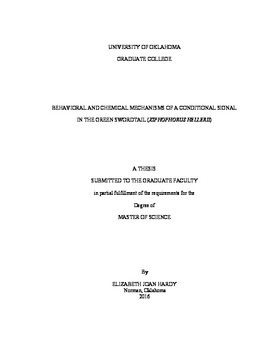| dc.description.abstract | Color polymorphisms are a common occurrence across most taxa. These differing forms of visual signals can act as a determinant for status and relative attractiveness for the choosy sex in a given species. While this provides many interesting avenues of research, we generally assume that differences in color give a signaler certain costs or advantages, depending on their phenotypic expression. In one population of the livebearing fish species Xiphophorus hellerii, a dimorphic trait in other populations has become a conditional, dynamic color signal. Males in this population can change their lateral stripe color to adapt to their social environment. This ability puts into question how individuals communicate within this population and amongst allopatric non-shifting populations.
Using a series of behavioral trials, we tested: 1) what mode of communication triggers color change and how male aggression is impacted 2) what preferences may exist amongst females for particular stripe color and 3) how shifting males allocate behaviors towards males and females from the same and from two allopatric populations. When comparing isolated modalities, visual communication initiated greater color change and aggression over chemical communication. However, when comparing mixed modalities there was not a clear trend. Females showed no distinct preference for a particular color stimulus, suggesting stripe color alone is not solely utilized in mate choice. We found that males do not change stripe color differentially towards different male stimuli based on population, but had a significant preference for sympatric females. Additionally, we investigated a potential chemical mechanism for stripe change, using two of the most common endogenous compounds, norepinephrine and epinephrine, implicated in teleost color change. Both compounds failed to initiate a change, thus suggesting a different hormone or neurotransmitter may be the trigger for color expression. These findings raise further questions as to the function and production of visual cues, as well as potential prioritization of signaling. | en_US |
